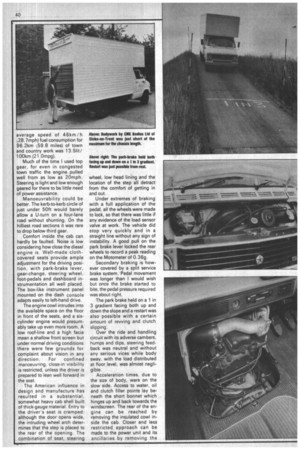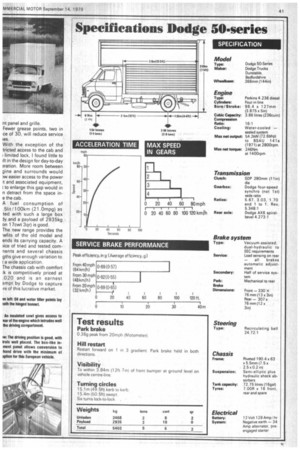Dodge enlarges its van appeal
Page 41

Page 42

Page 43

If you've noticed an error in this article please click here to report it so we can fix it.
iII Brock describes an on-the-road example of Dodge's ?placement for e Walknru and road-tests it.
HE NEW Dodge Truck 50cries does more than merely .place the veteran Walk-Thru todels, it offers a wider choice f gross vehicle weight, which ow extends from 3.5 to 7.5 >nnes (3.44 to 7.38tons). It ill now be fully competitive for plume sales.
Until the integral van model ecomes available later this
:at-, production will be concenated on chassis-cab and iassis-cowl versions, which ill take a wide variety of body pes and sizes.
The S56 model presented for st was fitted with a Luton body CME Bodies Ltd of Stoke-on:ent, just one of 20 British Aybuilders approved by odge. It was 75mm (3in) loner than the maximum pos)le with a 3660mm (144in) leelbase chassis.
The new chassis has a lower imp over the drive axle in der to facilitate easy rnoun ig, but the 4.04m ;159in) neelbase chassis will still cept bodies originally fitted to e previous 3.94m ;155in) KC odel.
The suspension has been pmpletely changed. Longer rings with fewer leaves both the front and rear are almost ) per cent lighter. They are of nventional semi-elliptic de in with rubber-bushed spring • es for maintenance-free ounting. The initial production n employed lever-type shock sorbers but by now all new hides should be fitted with telescopic dampers. This suspension improves ride and handling laden and unladen, claims the maker.
There are three wheelbase options throughout the range. Four engine options are also available, but for models above 4.6 tonnes gvw the least powerful 1981cc C120cuin) four-cylinder petrol unit is not recommended. The Perkins four-cylinder inline 3.87-litre (236cuin) diesel with a power output of 54.2kW ,72.6bhp) at 2800rpm and a maximum torque of 246Nm 82Ibft) at 1400rpm, is standard here. There are also six-cylinder diesel and petrol options.
Dodge's four-speed gearbox, though, has not changed a bit since the time we referred to it as Chrysler. It still has synchromesh on the top three ratios only but there are options: the synchromesh five-speed Turner box or, for six-cylinder engines, an automatic.
The vehicle on test, with a four-cylinder diesel engine and a large box body presenting a large frontal area, is definitely not a high-speed long-distance machine. More power would be needed for that application.
The riveted aluminium body measuring 3.81m 2ft 61n) x 2.05m i,6ft 9in) x 2.29m ;7ft 61n) high and the Luton 1.4m 3ft 9in) x 2.05m ,6ft 9in) x 1.02m ;3f1 4in) high gives a capacity of 20.24cum ;714cuft) at a weight of only 300kg ;5.9cwt) allowing a playload of 3132kg (3ton lcwt 3qr).
Over our test route the vehicle was able to maintain a good speed and fitted in with the traffic flow well. At an average speed of 46km /h ,28.7mph) fuel consumption for 96.2km ;59.8 miles) of town and country work was 13.51it/ 100km (21.0mpg).
Much of the time I used top gear, for even in congested town traffic the engine pulled well from as low as 20mph. Steering is light and low enough geared for there to be little need of power assistance.
Manoeuvrability could be better. The kerb-to-kerb circle of just under 50ft would barely allow a U-turn on a four-lane road without shunting. On the hilliest road sections it was rare to drop below third gear.
Comfort inside the cab can hardly be faulted. Noise is low considering how close the diesel engine is. Well-made clothcovered seats provide ample adjustment for the driving position, with park-brake lever, gear-change, steering wheel, foot-pedals and dashboard instrumentation all well placed. The box-like instrument panel mounted on the dash console adapts easily to left-hand drive.
The engine cowl intrudes into the available space on the floor in front of the seats, and a sixcylinder engine would presumably take up even more room. A low roof-line and a high facia mean a shallow front screen but under normal driving conditions there were few grounds for complaint about vision in any direction. For confined manoeuvring, close-in visibility is restricted, unless the driver is prepared to lean well forward in the seat.
The American influence in design and manufacture has resulted in a substantial, somewhat heavy cab shell built of thick-gauge material. Entry to the driver's seat is cramped: although the door opens wide, the intruding wheel arch determines that the step is placed to the rear of the opening. The combination of seat, steering
wheel, low head lining and the location of the step all detract from the comfort of getting in and out.
Under extremes of braking with a full application of the pedal, all the wheels were made to lock, so that there was little if any evidence of the load sensor valve at work. The vehicle did stop very quickly and in a straight line without any sign of instability. A good pull on the park brake lever locked the rear wheels to record a peak reading on the Motometer of 0.36g.
Secondary braking is however covered by a split service brake system. Pedal movement was longer than I would wish but once the brake started to bite, the pedal pressure required was about right.
The park brake held on a 1 in 3 gradient facing both up and down the slope and a restart was also possible with a certain amount of revving and clutch slipping.
Over the ride and handling circuit with its adverse cambers, humps and dips, steering feedback was neutral and without any serious vices while body sway, with the load distributed at floor level, was almost negligible.
Acceleration times, due to the size of body, were on the slow side. Access to water, oil and clutch filler points lay beneath the short bonnet which hinges up and back towards the windscreen. The rear of the engine can be reached by removing the insulated cowl inside the cab. Closer and less restricted approach can be made to the power unit and its ancillaries by removing the nt panel and grille.
Fewer grease points, two in ce of 30, will reduce service les.
With the exception of the tricted access to the cab and ! limited lock, I found little to It in the design for day-to-day .eration. More room between gine and surrounds would ny easier access to the power it and associated equipment, t to enlarge this gap would in n detract from the space ine the cab.
A fuel consumption of .51it/1 00km (2 1.0mpg) as ted with such a large box iy and a payload of 293 5kg on 1 7cwt 3gr) is good.
The new range provides the lefits of the old model and ends its carrying capacity. A )ice of tried and tested cornnents and several chassis gths give enough variation to t a wide application.
The chassis cab with comfort :k is competitively priced at ,020 and is an earnest ampt by Dodge to capture ire of this lucrative market.




















































































































































